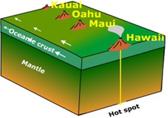Partial Melting
Partial melting – what really happens at hot spots and plate boundaries:
First, let’s blow a common myth – the Earth’s mantle is not molten – seismic wave behaviour tells us that it is almost entirely solid rock. Indeed, were that not so, then volcanoes would be popping up all over the shop! Rocks, in both the mantle layer and the crust, begin to melt only in exceptional circumstances. Since some rock-forming minerals have lower melting temperatures than others, it is normal for partial melting to take place, the resulting magma being squeezed out of the parent rock and upward toward the surface. Of course, as magma progresses upward, it may begin to cool and crystallise; or it may cause the surrounding crustal rocks to start melting… the result is a huge variety of different igneous rocks.
Take an imaginary journey into the Earth’s interior: as you descend, the temperature increases (around 20oC per km), but so, too does pressure, due the weight of all that rock on top! This is what constrains the rock from melting – about the closest it normally gets to melting is in a part of the upper mantle known as the “seismic low velocity zone”, or aesthenosphere, where the rock is “on the verge” of partial melting, and so behaves in a more ductile manner. It is this layer that allows the motion of the tectonic plates above and, not surprisingly, it is within this layer that partial melting of mantle rock is most likely to occur - either due to increased temperature, or reduced pressure, or the introduction of volatiles such as water which have the effect of lowering melting points.
 Hot Spot Volcanoes like Hawaii occur where deep-seated “mantle plumes” bring hot rock up from the core-mantle boundary. Mantle rock is both solid and capable of convection, just as solid ice can flow downhill in a glacier! The rise in temperature allows partial melting in the aesthenosphere, generating hot, runny basalt magmas that are typical of this kind of volcanism, As the plate moves over the static Hot Spot beneath, so the volcanic centre at the surface appears to change position over time forming, in the case of Hawaii, a chain of islands and seamounts stretching over more than a thousand kilometres.
Hot Spot Volcanoes like Hawaii occur where deep-seated “mantle plumes” bring hot rock up from the core-mantle boundary. Mantle rock is both solid and capable of convection, just as solid ice can flow downhill in a glacier! The rise in temperature allows partial melting in the aesthenosphere, generating hot, runny basalt magmas that are typical of this kind of volcanism, As the plate moves over the static Hot Spot beneath, so the volcanic centre at the surface appears to change position over time forming, in the case of Hawaii, a chain of islands and seamounts stretching over more than a thousand kilometres.Mid Ocean Ridges and Rift Volcanoes:
Mid Ocean Ridges and Rift Volcanoes: (e.g Iceland or East African Rift) occur where the Earth’s outer layer, the lithosphere (crust and uppermost mantle) is being pulled apart. As the lithosphere stretches and thins, the aesthenosphere gets closer to the surface, and pressure is reduced, in turn causing partial melting. Again, basalts are typically produced which, at mid-ocean ridges mostly erupt as pillow lavas on the sea floor. In continental rifts, magma rising through the thicker continental crust is much-modified, resulting in a wide variety of volcanic activity.
Island-Arc and Cordilleran Volcanoes
Island-Arc and Cordilleran Volcanoes form the “Pacific Ring of Fire”, as well as volcanoes in Malaysia, the Caribbean, etc. They form where a slab of old, cold, dense oceanic lithosphere sinks back into the mantle. As the descending plate heats up, water is released from the ocean-floor rocks; this lowers melting points in the adjacent mantle rock (crustal rock may also melt) forming thick, sticky andesite magma, rich in dissolved volatiles which, on reaching the surface, has a nasty tendency to erupt explosively.
Both animations from http://ansatte.uit.no/kku000/webgeology, an excellent site for more info.

